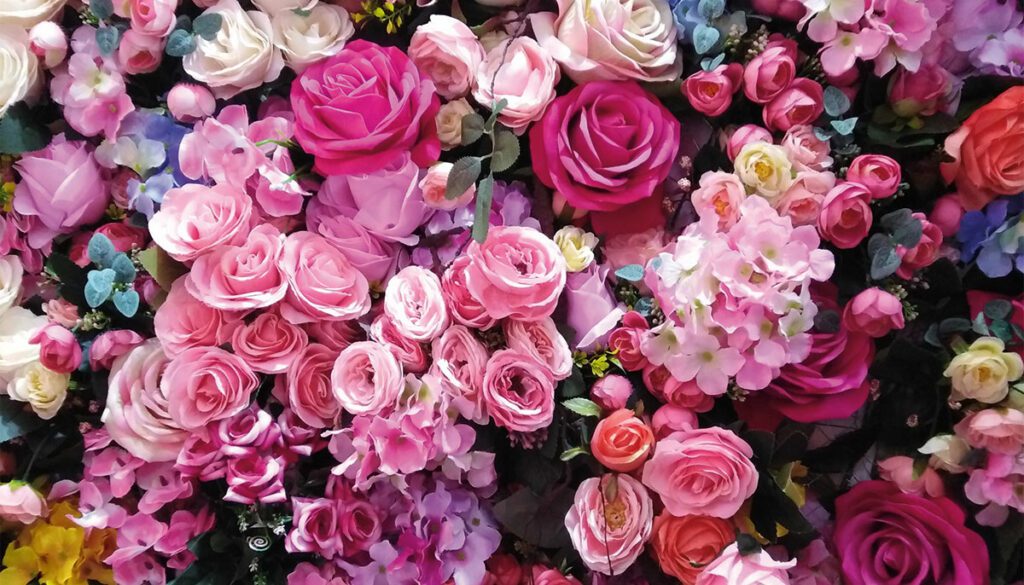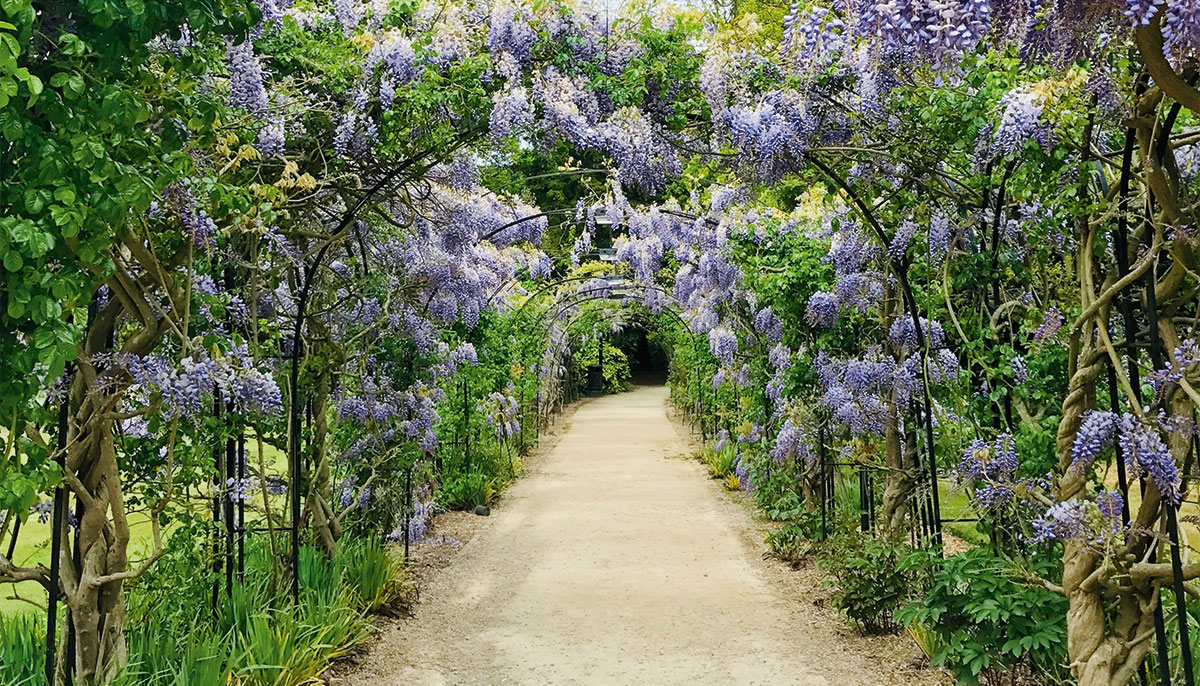I would rather go without food than without flowers. Sounds dramatic and it is. I recall a time years ago when I was desperate to touch the natural world. I was living in a third-floor walk-up in Queens, working at Burger King, and going to City University in Manhattan. On my way to class one day, I passed a street vendor selling roses by the bundle in shades of peach, scarlet, and magenta. Time stopped as I heard them whisper two words to every part of my body: “Take me.”
In those days I had a skin-tight budget and lived mostly on chicken livers, which I bought at a cut-rate grocery store for less than one dollar a container. I looked at the flowers. They looked at me. I calculated the cost in my head. Twenty bucks. TWENTY BUCKS! The flowers would cost me my entire food budget for the week. Although I knew the flowers were outside my budget, I bought them anyway because they weren’t just roses. They were the luxurious fulfillment of the desire to touch and smell something beautiful—warm rain pooling in the moonlight or a slow lifting fog—and that was priceless, so the roses were a bargain.
In my garden, nirvana manifests when I behold the true nature of a flower.
Roses remind me of the importance of beauty for beauty’s sake. Beauty is complete and gives generously. Growing up in Brooklyn, the natural world, generous and beautiful, seemed distant and inaccessible to me. The sun came up and set over the parched terrain of Bushwick’s row homes, concrete sidewalks, and chain-link fences. To see and feel grass, my brothers and I would run through The Evergreens Cemetery on Bushwick Avenue, one of the great urban forests of New York City, paying little or no mind to the tombstones. We were there to smell the green grass and feel it under our sneakers and to get close to muscular trees. We were chasing an emerging feeling, a fleeting sense of the timeless present—moments that glow in their luminosity and that cannot be possessed.
During this time spent at Evergreens, I was safe among the trees and flowers. They wanted nothing from me and gave me beauty not as a luxury concept but as a birthright to be known, felt, and lived.
My mother, a single parent working two jobs to support four kids, took in boarders who’d seen better days. Our sturdy brick house had oak doors with beveled glass, and nearly every room, including the tiniest, the hall room, which was little more than a closet, was occupied by boarders, older men. Innocent and available, I was left in the house and subjected to sexual abuse by these tenants until they left or ran out of money to pay rent. The terror of the abuse was in contrast to the beauty of Evergreens, to the daffodils and cherry blossoms in spring. Because of the terror, I held onto the beauty of Evergreens, which could not be damaged, destroyed, or diminished, which was beyond the physical landscape and pointed instead to a horizon within me, tranquil and unstained.
That is why, many years later, when I moved from Brooklyn into my barn-like home outside Philadelphia, I set out to create something beautiful—a garden to transform the “mud” of life into a “lotus.” To paraphrase Wendy Johnson, one of the founders of the Garden Program at Green Gulch Zen Center in California, there are three good reasons to grow flowers: for beauty, for the coming apart of beauty, and to begin again. This wisdom aligns with the three seals: impermanence (anitya), nonself (anatman), and nirvana. These are the three seals that, according to many East Asian Buddhist traditions, are the essential teachings present in all authentic practices of the Buddha. Growing flowers is a living lesson on each of these three seals.
Impermanence
As a dharma teacher in the Plum Village tradition founded by Thich Nhat Hanh, I’ve learned the inescapable reality of impermanence, not as a theory but as an ongoing practice. Ultimately, everything and everyone changes, despite resistance to change. Flowers decompose; a child becomes an adult; day becomes night. The shifting nature of reality calls on us to practice—to love, to care, to accept, to occupy space and time, to release, to let go.
This loving and letting go is the essence of gardening, and it’s a lesson I relearned in my garden through an old flowering wisteria that was growing over the cottage roof and threatening to rip off the shingles with its branching, leafless, wooden tentacles. Slowly, little by little, I cut back the vine and trained it over a substantial wooden pergola. In late spring it bloomed a voluptuous cascade of blue to purple flowers, perfuming the air for a time, until the petals fell. Impermanence teaches me that things ripen, flower, and fade away in a continuous cycle of beauty, being, and becoming. It teaches me gratitude and appreciation for each day, each moment. I’ve learned that I can change my relationship to the abuse that happened to me like I can shape a vine, with love, understanding, patience, and practice. There is hope, healing, and growth.

Nonself
Often misunderstood, nonself isn’t about annihilation but rather about interconnectedness or interbeing, a term coined by Thich Nhat Hanh. From the pandemic, we’ve learned in a new and deeper way the truth of interconnectedness. What happens to me affects you, and what happens to you affects me.
Interconnectedness can be seen in a garden. A flower doesn’t grow in isolation. It’s permeated by nonflower elements, such as sunlight, soil, water, and air. It cannot exist without these nonflower elements. Living with an awareness of this interconnectedness, I have shifted how I tend plant life to increase the variety of native flowers, trees, and shrubs, which are adapted for local conditions and, therefore, require less maintenance and offer food sources to local native wildlife. Their deep root system holds sediment in place, helping to stabilize the areas where they’re planted and increase the soil’s capacity to store water, reducing runoff and flooding. These native plants are vital to creating a healthy ecosystem that supports a diversity of birds, insects, and other animals. They cohabitate in the garden; they are interconnected.
One of my first native plantings that now has spread in waves throughout my garden is coreopsis tinctoria, a host plant to forty-two different pollinators. In early fall the plant is covered with finches and sparrows that eat the seeds. I also have the lemon-scented yellow flowers of oenothera biennis, a biennial plant. Hummingbirds, honeybees and bumblebees, and several moth species, including the primrose moth, eat the nectar. Several caterpillars eat the foliage, including the pearly wood-nymph, grape leaffolder moth, and white-lined sphinx. The plant’s seeds are eaten by several bird species, including goldfinch.
When you really look at a flower, you begin to see this interconnectedness of the roots stabilizing the soil, the nectar providing food for butterflies and insects, and seed heads offering nourishment for birds. Looking deeper, you appreciate the kinship connecting flower to flower, and flowers to nonflower elements and to everything else.
Nirvana
Thich Nhat Hanh taught that nirvana is the extinction of ideas. The ultimate dimension of existence, nirvana is beyond concepts of right and wrong, coming and going, birth and death. Clinging to any concept, even the concepts of impermanence, nonself, and nirvana, leads to suffering. So, instead of clinging, we can connect with the essence of the three seals. This essence is about living our daily lives with generosity, interconnectedness, and mindful awareness.
In my garden, nirvana manifests when I behold the true nature of a flower, embracing suffering and vulnerability in the light of compassion. I walk through my garden and touch the flowers of the limelight hydrangea. I touch a threshold full of grace, full of aliveness. I exhale and the flowers whisper back: “Take me.”

